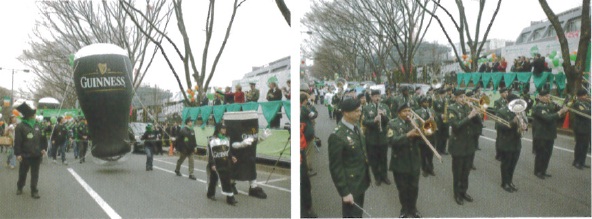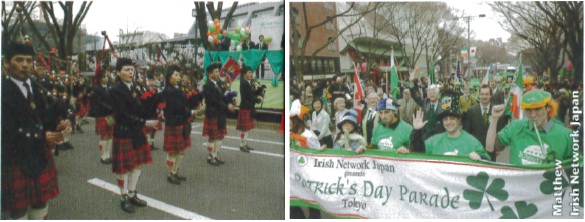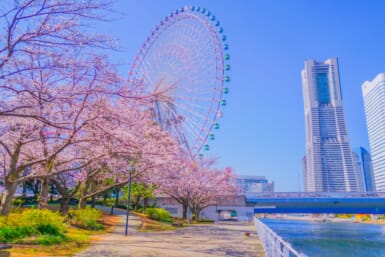Even Tokyo goes “Irish for a day”
by Jeff Richards
With Mar. 17 just around the corner, the world readies itself for the annual ‘wearin o’ the green.’ St. Patrick’s Day, Ireland’s national holiday, is celebrated by more people living outside the Emerald Isle than in. And just in case you hadn’t noticed, what with all the Guinness being served in Tokyo and cookie-cutter Irish pubs sprouting like clover, Japan is as keen as any other nation to be Irish for a day.
St. Paddy’s Day
Ireland itself spends a week celebrating its national holiday in much the same manner as Americans celebrate the Fourth of July. The official ‘St. Patrick’s Festival’ in Dublin takes place over four days from Mar. 15-19. This event, however, started only in 1996 as a response to the fact that the parades and festivities in Ireland itself paled in comparison to the spectacles put on elsewhere in the world. The most prominent being cities like Boston and New York that break out in a green frenzy come the middle of March. Since its inception, Dublin’s own St. Patrick’s Festival now attracts more than 1.2 million visitors over four days of fireworks, parades, street theater, and general revelry.
So who was St. Patrick, and why do we fall all over ourselves like neophyte step-dancers on his day?
One of the most famous Christian saints of all time, Patrick was born of well-off parents in England near the end of the fourth century. In 401 A.D. a group of Celts doing a little bit of good, old-fashioned raping and pillaging through the English countryside kidnapped the then 16 year old, and brought him back to Ireland with the rest of their booty. There, they sold him to a sheep farmer, and headed off once more on their insatiable pagan search for the great plunders of the world.
As a slave, the young Pat lived in a hut, tending the sheep, and speaking to nobody but God. One day, perhaps interrupted mid-monologue, he received a divine message telling him to return to England. Living amongst heathens and having by this time talked himself into devout Christianity, what more could a young man do? He cut his woolen bonds and hoofed it to the coast, getting captured one more time along the way before finally gaining passage on a ship back to England.
You’d think that six years of slavery and forced labor would be enough of Ireland for one man, but not for Patrick. At the age of 45, Patrick is ordained a bishop, and with the blessing of the Pope, he returned to Ireland.
He had an easy way with the Celts. He knew their language, knew their connection to the land, and knew their gods and pagan rituals (which he vowed to eliminate). Legend has it that he used the shamrock that grew in abundance as a means of explaining the Holy Trinity. In recognition of their Sun God, he created the Celtic cross with the sun radiating from the center. Legend also says he banished all the snakes and serpents from Ireland. In fact, there never were snakes in Ireland, splitting off from the continent as it did so many millennia ago. It is certainly a metaphor revered by Christians, though, regarding Patrick’s work in spreading the word of God, and the victory of Christianity over the pagans in Ireland.
He racked up the points with his ministry. With over 1,000 conversions, and several hundred church completions, he’s arguably the top candidate for the Roman Catholic All-Star Team.
Patrick died on Mar. 17, 461 A.D., whereupon he was made a Saint, and the Patron Saint of Ireland. His day is a national holiday, but it is also an important religious holiday. With the exception of restaurants and pubs, all businesses in Ireland close on this day. Many Irish attend mass, as it is the traditional day to offer up prayers for missionaries worldwide. With that out of the way, it’s time for some serious celebrating.
Irish in Japan: My Guiness My Goodness
I don’t know when the Irish invaded Japan, but they didn’t do it with shillelaghs. They did it with barrels of Guinness, and bottles of Bushmills. According to Aislign Braiden, Cultural Attache for the Embassy of Ireland, they estimate that between 1,500 and 2,000 Irish nationals are currently living and working in Japan. It’s hard to tell, she stresses, because many foreign nationals living in Japan don’t register with their embassy (which, by the way, one should do. See page six). This is just a fraction of the over 100,000 non-Irish westerners (2003 est.) living here.
Yet, there is no shortage of Irish pubs in Tokyo. In this city, it seems that you can’t turn the corner without bumping into a ‘traditional’ Irish pub. When I walk around Tokyo, I am rarely confronted by Bavarian beer halls, French bistros, or Canadian pancake and syrup huts. Even that Hollywood staple of the new world landscape, the cheeseburger-and-fries American diner, is rare (not to mention outrageously expensive). I mean, it’s hard enough just to find a place to watch ice hockey.
If you’re partial to a draught of Guinness, though, living in the metropolis means that you’ll never have to go thirsty in that regard. The sheer amount of Irish pubs and drinking establishments serving traditional Irish libations is astounding. One is compelled to use the term ‘plethora’, but the actual number of Irish pubs in the Kanto area sits at around 42. Nationwide, there are upwards of 70, reckons Enterprise Ireland, the Irish trade board in Japan. That’s one public house for every 28 and a half Irish lads and lasses living here. Welcome to the land of the rising pint.
Almost Famous: The Legacy of Lafcadio Hearn
Speaking of drinking in dark places, for those enamored of the Irish literati, the idea of stinging asides and nonchalant brilliance is never far from a recently refilled glass of stout or dram of whiskey with an ‘e.’ While Samuel Beckett, Oscar Wilde, G.B. Shaw, or Brendan Behan et. al. may never have ventured to these shores, Japan has its own small tie to the great literary tradition of Ireland.
In fact, Japan’s most famous Irishman was a prolific writer in the finest Gaelic tradition, and is responsible for many of the first accounts of Japanese life that were read by Westerners after the fall of the Tokugawa shogunate. Lafcadio Hearn was born on the island of Lefkada, Greece (hence the name), the son of an Irish Sergeant-major. Relocating back to Dublin at the age of six, he eventually went on to write for Harper’s Magazine while living in the U.S. and spent two years in the West Indies as a foreign correspondent. Sent to Japan on assignment in 1889, he never left.
Settling in the town of Matsue in Shimane prefecture, Kyushu (an obvious choice for the Irish football team’s pre-tournament camp during the 2002 World Cup), he married the daughter of a Samurai family, Set-su Koizumi, and as a naturalized Japanese took on the name Koizumi Yakumo. In Kumamoto, while teaching at a high school, he wrote his first and perhaps most famous book on Nippon: Glimpses of Unfamiliar Japan. Following that, he took a journalist post with the Kobe Chronicle, an early English-language newspaper. Then in 1896, with the help of his friend, the foremost British Japanologist at the time, Basil Hall Chamberlain, Hearn began teaching English literature at the Tokyo Imperial University. It was a position he held until 1903. He died the following year at the age of 54, the author of 14 definitive texts on his adopted Japan. (See sidebar)
Nowadays, he is probably better known within Japan than outside of it. The volumes of Japanese legends and ghost stories left by Hearn as Koizumi Yakumo have scared the faith and begorrah out of generations of Japanese children. Kobayashi Masaki turned his collection of tales Kwaidan: Stories and Studies of Strange Things into the movie Kwaidan in 1965.
Irish for a day
Now, the green is few and far between here in the bustling ‘burgh of Tokyo, but that’s no reason to despair. If you want to get your blarney on, Tokyo just happens to host the largest St. Paddy’s Day parade in Asia — and the oldest. In fact, a quick search of Paddy’s Day events in Asia reveals one each in Malaysia, Korea and Singapore. Three can be found in China (Hong Kong, Shanghai, and Beijing). Japan, however, will celebrate with six, count ’em, six parades: in Tokyo, Yokohama, Kyoto, Ise, Nagoya, and this year for the first time, Sendai.
All of these events are overseen by the Irish Network Japan (INJ) and their six respective regional branches. The INJ is a non-profit organization dedicated to promoting Irish culture in Japan. This year, the INJ marks the 15th Anniversary of the Tokyo St. Patrick’s Day Parade.
Derek Fitzgerald expects around 40,000 spectators this year. As INJ chairperson, he has managed to volunteer his spare time over the past four years as the man responsible for spreading the craic in Japan. If you have ever been one of the multitudes lined up in Omotesan-do for the annual parade, then you have participated in the signature event that Derek and the INJ produce each year — and experienced what craic is all about.
If you haven’t had the pleasure, and you want to go green, head down to Omotesando on Sun., Mar. 19. The parade runs from 2-4pm rain or shine. Expect to see some special guests (Irish President Mary McAleese attended last year) and give a hearty welcome to new Irish Ambassador Brendan Scannell. There is an open door policy for parade participants, and if you and your group decide to jimmy a float together at the last minute; then push, pull or drag it to Shibuya Jingumae School at 9am the day of, and get involved. Volunteers are always welcome. See www.irish-network-japan.com for more details.
Erin go bragh!
Books on Japan by Lafcadio Hearn
A catalogue of books written by Lafcadio Hearn. Japan’s most famous Irishman wrote volumes about the Japanese spirit and way of life. Known as Koizumi Yakumo after becoming naturalized his tales of Japanese ghosts are still read by schoolchildren.
- Glimpses of Unfamiliar Japan (1894)
- Out of the East: Reveries and Studies in New Jарап (1895)
- Kokoro: Hints and Echoes of Japanese Inner Life (1896)
- Gleanings in Buddha-Fields: Studies of Hand and Soul in the Far East (1897)
- Exotics and Retrospectives (1898)
- Japanese Fairy Tales (1898) and sequels
- In Ghostly japan (1899)
- Shadowings (1900)
- Japanese Lyrics (1900) – on haiku
- A Japanese Miscellany (1901)
- Kotto: Being Japanese Curios, with Sundry Cobwebs (1902)
- Kwaidan: Stories and Studies of Strange Things (1903) (which was later made into the movie Kwaidan by Masaki Kobayashi)
- Japan: An Attempt at Interpretation (1904; published just after his death)
- The Romance of me Milky Way and other studies and stories (1905; published posthumously)











